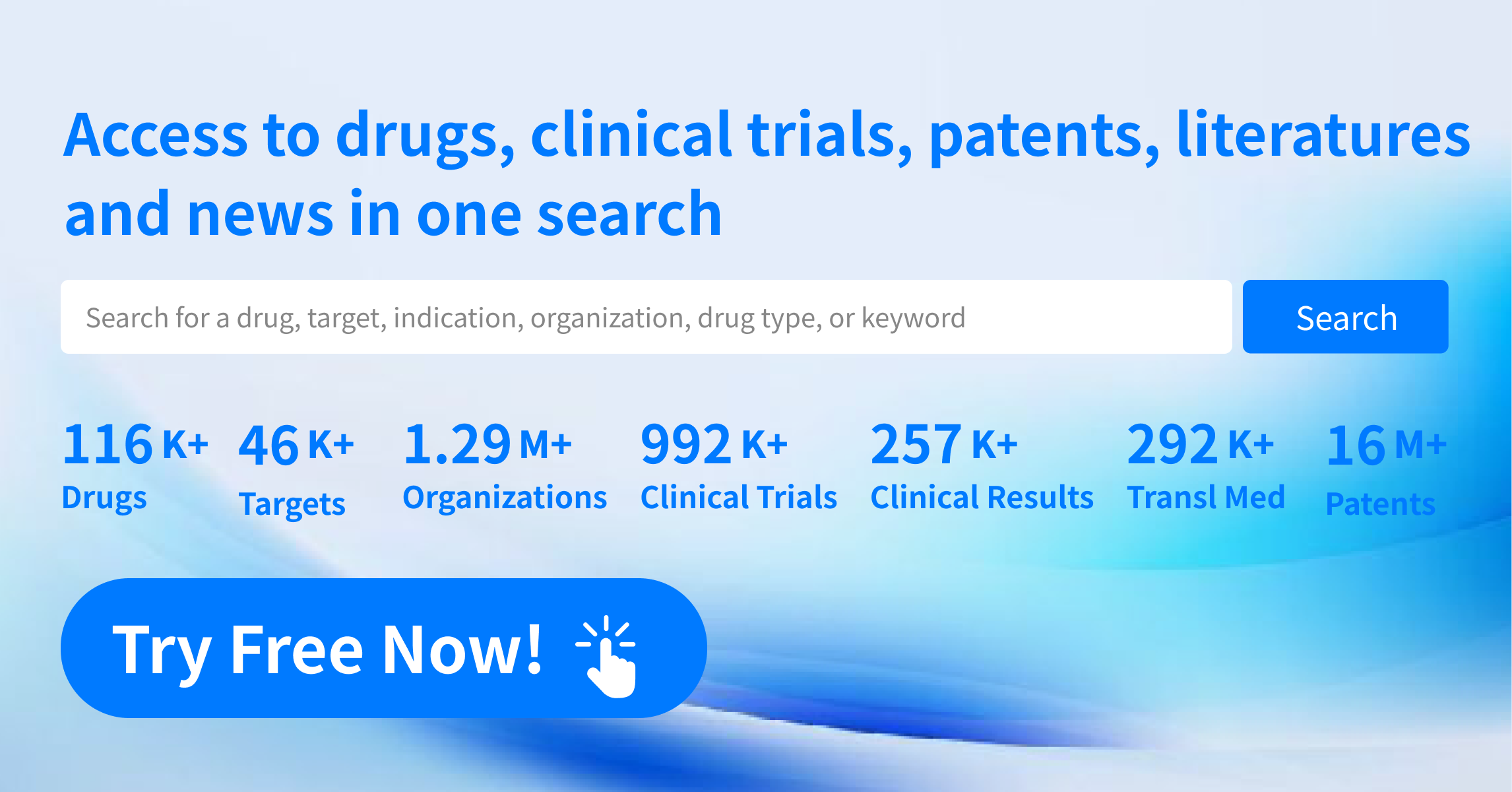May 2025 Drug Approval Wave: From KRAS-Targeted Combinations to Novel ADCs in NSCLC
In May 2025, the global pharmaceutical landscape witnessed a wave of innovation. From treating rare diseases such as KRAS‑mutant low‑grade serous ovarian cancer, pheochromocytoma, and paraganglioma to addressing widespread public health conditions like chronic obstructive pulmonary disease (COPD), postoperative pain, and influenza A virus infection, this series of drug approvals not only highlights the tireless efforts of medical researchers to overcome challenging diseases, but also reflects pharmaceutical companies’ ongoing commitment to advancing personalized and precision medicine. Notably, many of this month’s approved drugs are based on cutting‑edge biotechnologies and molecularly targeted therapies, offering new hope for patients with resistant or hard‑to‑treat conditions.
1. Avutometinib/Defactinib
Avutometinib/Defactinib (AVMAPKI FAKZYNJA CO-PACK), developed by Verastem, is a combination of small-molecule drugs approved in the United States on May 8, 2025 for the treatment of KRAS‑mutant low‑grade serous ovarian cancer.
Avutometinib is a RAF/MEK inhibitor that blocks the RAS‑RAF‑MEK‑ERK signaling pathway. It selectively inhibits MEK kinase activity, preventing downstream ERK activation and suppressing tumor cell proliferation and survival—a critical action in tumors harboring KRAS mutations that drive pathway hyperactivation.
Defactinib is a focal adhesion kinase (FAK) inhibitor that disrupts tumor–stroma interactions, thereby reducing cancer cell migration, invasion, and metastatic potential. FAK is essential for cytoskeletal remodeling, adhesion, and motility; its overexpression is associated with numerous cancers.
The combination yields synergistic effects: juntos they inhibit cell proliferation and prevent metastasis, offering a comprehensive therapeutic option for KRAS-mutant low-grade serous ovarian cancer. Clinical data demonstrate significant tumor growth inhibition and extended progression-free survival, improved patient quality of life, and a favorable safety and drug interaction profile.
Verastem employed advanced formulation and pharmacokinetic design to ensure stability and bioavailability, showing comparable or superior efficacy compared with single agents. Post-approval, the company plans further pharmacovigilance, Phase IV trials to optimize dosing, expand indications, and evaluate long-term outcomes.
Among current targeted therapies, several RAF/MEK and FAK inhibitors exist—Amgen’s Lumakras (sotorasib) and Mirati’s Adagrasib target KRAS G12C mutation directly—yet are mutation-specific. In contrast, Avutometinib/Defactinib offers broad-spectrum pathway inhibition, addressing complex KRAS-mutant cases. AstraZeneca’s Selumetinib (a MEK inhibitor) is another competitor, used in certain neurofibromatosis subtypes.
2. Velaglucerase Beta
Velaglucerase beta (CAN‑103), developed by CANbridge Life Sciences, received approval in China on May 13, 2025 for the treatment of Gaucher disease types I and III.
It is a humanized recombinant β‑glucocerebrosidase enzyme replacement therapy. Gaucher disease, caused by GBA gene mutations, results in deficient glucocerebrosidase activity, leading to intracellular lipid accumulation—especially in macrophages (so-called Gaucher cells)—and manifestations such as hepatosplenomegaly, bone disease, and systemic involvement. Velaglucerase beta provides functional enzyme to degrade stored glucocerebroside into glucose and ceramide, preventing lipid accumulation, restoring metabolic balance, and improving clinical outcomes.
This enzyme demonstrates high stability and bioavailability, rapidly distributing to target tissues post-infusion and sustaining therapeutic effect. Clinical trials confirmed it significantly reduced liver and spleen volume, alleviated bone pain, increased hemoglobin, improved platelet counts, and enhanced quality of life—without serious adverse events.
CANbridge utilized advanced bioprocessing and pharmacokinetic optimization to achieve equivalent or superior efficacy compared to existing enzyme replacement therapies. Following market approval, CANbridge will continue pharmacovigilance and Phase IV studies to expand indications and assess long-term efficacy.
Existing Gaucher enzyme therapies include Sanofi’s Cerezyme and Pfizer’s Vpriv, both delivering exogenous enzyme effective for symptom improvement but subject to immune reaction-related variability. Velaglucerase beta, as a new humanized recombinant enzyme, offers improved affinity, lower immunogenicity, and high purity and stability—making it a favorable alternative in enzyme replacement therapy.
3. Anrikefon
Anrikefon (HSK-21542), developed by Haisco Pharmaceutical Co., Ltd., was approved in China on May 13, 2025, for the treatment of postoperative pain.
Anrikefon is a selective κ-opioid receptor agonist that exerts analgesic effects primarily by specifically binding to and activating κ-opioid receptors in the central and peripheral nervous systems. Compared to traditional μ-opioid receptor agonists, κ-opioid receptor agonists offer lower risks of addiction and respiratory depression while effectively relieving pain. By activating downstream signaling pathways through κ-receptor binding, Anrikefon suppresses nociceptive neuron activity and reduces the transmission of pain signals. Additionally, κ-opioid receptors play a role in emotional and stress regulation, making Anrikefon not only effective in relieving acute pain but also beneficial in improving mood and alleviating anxiety and depressive symptoms.
Studies have shown that Anrikefon has high affinity and selectivity in vivo, delivering significant analgesic effects at lower doses and avoiding common side effects of traditional opioids, such as constipation, nausea, and vomiting. This unique mechanism of action positions Anrikefon as a highly promising novel analgesic.
Clinical data demonstrate that Anrikefon provides excellent postoperative pain relief, significantly lowering pain scores and reducing the need for additional analgesics without causing severe adverse events or drug interactions.
Currently, the postoperative pain management market includes widely used analgesics such as nonsteroidal anti-inflammatory drugs (NSAIDs) and traditional opioids like morphine and oxycodone. While these drugs are effective in pain relief, they often come with adverse effects such as addiction, respiratory depression, and gastrointestinal disturbances. In contrast, Anrikefon, as a selective κ-opioid receptor agonist, provides superior safety and tolerability, reducing the risk of adverse effects while maintaining effective analgesia.
Other competing products include Pfizer’s Remoxy (an extended-release opioid) and Egalet’s Arymo ER (an abuse-deterrent formulation of morphine), both designed to minimize misuse and side effects through enhanced drug delivery technologies.
4. Birociclib
Birociclib, developed by Xuanzhu Pharmaceutical Technology Co., Ltd., was approved in China on May 13, 2025, for the treatment of HR-positive/HER2-negative breast cancer.
Birociclib is a selective cyclin-dependent kinase 4 and 6 (CDK4/6) inhibitor. It works by specifically inhibiting the CDK4/6–cyclin D complex, thereby preventing phosphorylation of the retinoblastoma (Rb) protein. When Rb is unphosphorylated, it halts cell cycle progression from the G1 to S phase, effectively suppressing tumor cell proliferation.
In HR-positive/HER2-negative breast cancer, the estrogen receptor (ER) signaling pathway is frequently activated, leading to increased cyclin D expression and promoting Rb phosphorylation via CDK4/6. Birociclib blocks this pathway, thereby halting tumor cell growth and division. Moreover, CDK4/6 inhibitors have also been shown to enhance immune system recognition and elimination of tumor cells, potentially producing synergistic effects when used with immunotherapies.
Studies demonstrate that Birociclib has high selectivity and affinity, achieving potent antitumor effects at lower doses with minimal impact on normal tissues.
Clinical trial results show that Birociclib significantly prolongs progression-free survival (PFS) and increases objective response rates (ORR), improving overall clinical outcomes without serious adverse events or notable drug interactions.
The HR-positive/HER2-negative breast cancer treatment landscape already includes several widely used CDK4/6 inhibitors such as Pfizer’s Ibrance, Novartis’ Kisqali, and Eli Lilly’s Verzenio. These agents block tumor cell proliferation by targeting CDK4/6 and have proven effective in extending PFS and improving quality of life. However, variations in side effect profiles and tolerability among patients can limit their use. In comparison, Birociclib offers higher selectivity and a more favorable safety profile, providing a safer and more effective treatment option for patients.
5. Telisotuzumab Vedotin
Telisotuzumab vedotin (ABBV-399, ABT-399), developed by AbbVie with support from Pierre Fabre SA, received its first approval in the United States on May 14, 2025, for the treatment of c-Met–positive non-squamous non-small cell lung cancer (NSCLC).
Telisotuzumab vedotin is an antibody-drug conjugate (ADC) that exerts potent and selective anti-tumor activity by specifically binding to c-Met receptors on the surface of tumor cells and delivering the cytotoxic payload vedotin directly into the cancer cells. The antibody portion of the ADC is a humanized monoclonal antibody that selectively targets c-Met, a receptor that is overexpressed in various types of cancer, particularly in c-Met–positive non-squamous NSCLC. Upon binding to c-Met, the ADC is internalized into the tumor cell, where it releases the cytotoxin monomethyl auristatin E (MMAE), a microtubule inhibitor. MMAE disrupts microtubule polymerization, resulting in cell cycle arrest and apoptosis.
Thanks to this targeted delivery mechanism, Telisotuzumab vedotin can efficiently kill tumor cells while sparing normal tissues, enhancing efficacy and minimizing systemic toxicity. Studies have shown that this targeted system improves antitumor activity and reduces adverse effects, offering a safer and more effective treatment option.
Clinical results demonstrated that Telisotuzumab vedotin significantly prolonged progression-free survival (PFS) and improved objective response rates (ORR), with no serious adverse events or significant drug interactions observed.
Currently, several targeted therapies and immune checkpoint inhibitors are widely used in the treatment of c-Met–positive non-squamous NSCLC, such as Merck’s Keytruda and Roche’s Tecentriq. However, these treatments primarily rely on stimulating the immune system to attack tumors and may have limited efficacy in tumors driven by specific mutations or overexpression, such as c-Met–positive NSCLC.
In contrast, Telisotuzumab vedotin, as a novel ADC, offers precise and potent targeting of c-Met, presenting a new and effective therapeutic option. Other competing products include Capmatinib and Crizotinib, both of which are small-molecule c-Met inhibitors. However, these agents are often associated with higher toxicity and resistance issues, making Telisotuzumab vedotin a promising alternative.
6. Boryung Flu Vaccine V
Boryung Flu Vaccine V (보령플루백신V주), developed by Boryung Biopharma, is a vaccine designed to prevent influenza A and B virus infections. It was first approved in South Korea on May 19, 2025, for the prevention of influenza A and B.
Boryung Flu Vaccine V is an inactivated influenza vaccine prepared using killed strains of influenza A and B viruses. It works by introducing inactivated viral antigens into the body to stimulate the immune system to generate specific antibodies. The inactivated virus particles retain key surface antigens—hemagglutinin (HA) and neuraminidase (NA)—which are recognized and remembered by the immune system.
Following vaccination, antigen-presenting cells capture and present these antigens to helper T cells and B cells, activating an adaptive immune response. B cells produce large quantities of antibodies, especially neutralizing antibodies that bind to the HA proteins on the virus surface, thereby blocking viral entry into host cells and preventing infection. In addition, memory B and T cells are generated, providing long-term immunity and enabling a rapid immune response upon re-exposure to the same or similar influenza viruses.
Given the annual antigenic changes in circulating influenza strains, the formulation of Boryung Flu Vaccine V is updated annually based on recommendations from the World Health Organization (WHO) to ensure optimal protective efficacy.
Currently, several influenza vaccines are widely available on the market, including Sanofi Pasteur’s Fluzone, GSK’s Fluarix, and AstraZeneca’s FluMist. These vaccines come in various forms, such as inactivated vaccines, live attenuated vaccines, and recombinant subunit vaccines. Each type has unique advantages and target populations. For instance, inactivated vaccines are suitable for most individuals, including the elderly and children; live attenuated vaccines are typically administered intranasally and are suitable for healthy individuals in specific age groups; recombinant vaccines are preferred for those with egg allergies or contraindications to traditional formulations.
Compared to existing options, Boryung Flu Vaccine V, as a new-generation inactivated vaccine, demonstrates high immunogenicity and a strong safety profile, offering effective protection for a broad population.
7. Onradivir
Onradivir (ZSP-1273), developed by Zhongsheng Pharmaceutical, was first approved in China on May 20, 2025, for the treatment of influenza A virus infections.
Onradivir is a small-molecule antiviral agent specifically designed to inhibit RNA-dependent RNA polymerase (RdRp) of the influenza A virus, thereby blocking the viral replication process. RdRp is essential for synthesizing the viral genomic RNA, a key step in the propagation and transmission of the virus. Onradivir binds to RdRp, disrupting its normal function and preventing the synthesis of viral RNA, thus inhibiting replication within host cells.
Studies show that Onradivir exhibits high selectivity and affinity, achieving potent antiviral effects at low concentrations while minimizing cytotoxicity to host cells. Moreover, because its mechanism of action targets a central step in the viral life cycle, Onradivir has a lower tendency to induce resistance mutations, giving it a potential advantage in long-term treatment. Compared to existing anti-influenza drugs such as Oseltamivir, which primarily inhibit viral neuraminidase, Onradivir directly targets a critical enzyme in viral replication, offering a more precise and effective therapeutic strategy.
Clinical studies have demonstrated that Onradivir significantly shortens the duration of illness, reduces viral load, and improves clinical symptoms, accelerating patient recovery without causing severe adverse events or drug interactions. Zhongsheng Pharmaceutical has also utilized advanced drug design and manufacturing technologies to ensure high stability and bioavailability, with detailed pharmacokinetic studies indicating efficacy comparable to or better than existing influenza therapies. Post-marketing, the company continues to monitor the drug’s performance and plans to conduct Phase IV clinical trials to explore additional indications and long-term benefits.
Currently, several antiviral drugs are available for treating influenza A virus infections, such as Tamiflu (Oseltamivir) by Roche and Relenza by GSK. These drugs function by inhibiting neuraminidase, preventing the release of newly formed viral particles from infected cells and slowing viral spread. However, the emergence of resistant viral strains has made the development of novel therapeutic strategies increasingly important. In this context, Onradivir, as a new RdRp inhibitor, provides a fundamentally different and more direct approach to suppressing viral replication. Other alternatives, such as Laninamivir by Merck, are long-acting neuraminidase inhibitors administered via a single inhalation dose, but their availability and use remain limited in certain regions.
8. Glecirasib
Glecirasib Citrate, developed by Jacobio Pharmaceuticals Group Co., Ltd., was first approved in China on May 20, 2025, for the treatment of non-small cell lung cancer (NSCLC) with KRAS G12C mutation.
Glecirasib is a selective small-molecule inhibitor that targets the KRAS G12C mutation, a known driver of oncogenesis in various cancers. It works by covalently binding to the cysteine residue at the G12C mutation site of the KRAS protein, thereby locking it in its inactive GDP-bound state and preventing downstream signaling activation.
Under normal physiological conditions, KRAS functions as a molecular switch that toggles between an active (GTP-bound) and inactive (GDP-bound) state to regulate cell proliferation, differentiation, and survival. However, in tumors harboring the KRAS G12C mutation, the protein remains constitutively active, leading to continuous signal transduction and uncontrolled cell growth. Glecirasib’s covalent binding to the mutant site inhibits the RAS-RAF-MEK-ERK signaling cascade, effectively suppressing tumor cell growth and metastasis.
Preclinical and clinical data demonstrate that Glecirasib offers high selectivity and potency, exerting strong antitumor effects at low doses while minimizing toxicity to normal tissues. Its unique mechanism of action also reduces the likelihood of resistance mutations, suggesting potential advantages for long-term therapy.
Currently, other approved therapies for KRAS G12C-mutant NSCLC include Lumakras (Sotorasib) by Amgen and Adagrasib by Mirati Therapeutics. These drugs also inhibit KRAS G12C and have been shown to significantly extend progression-free survival and improve quality of life. However, some patients develop resistance or are unable to tolerate their side effects. In contrast, Glecirasib, as a next-generation KRAS G12C inhibitor, offers greater selectivity and a more favorable safety profile, providing a promising alternative for patients with this difficult-to-treat mutation.
Other related therapeutic agents include Selumetinib by AstraZeneca, a MEK inhibitor used in the treatment of certain types of neurofibromatosis, which acts downstream of KRAS in the same signaling pathway.
9. Jaktinib Hydrochloride
Jaktinib Hydrochloride, developed by Zelgen Biopharma Co., Ltd., was first approved in China on May 27, 2025, for the treatment of adult patients with intermediate- or high-risk primary myelofibrosis (PMF), post-polycythemia vera myelofibrosis (PPV-MF), and post-essential thrombocythemia myelofibrosis (PET-MF). It is indicated for the reduction of disease-related splenomegaly and symptoms.
Jaktinib is the first domestically developed JAK inhibitor approved in China for myelofibrosis. It is a novel drug that inhibits JAK1, JAK2, JAK3, and TYK2, thereby blocking the JAK-STAT signaling pathway, which plays a central role in the pathogenesis of myelofibrosis. Additionally, it targets ACVR1, a receptor involved in iron metabolism, helping to correct iron dysregulation and improve anemia.
In a Phase III clinical trial, 72.3% of patients achieved a ≥35% reduction in spleen volume (SVR35) at 24 weeks, significantly outperforming hydroxyurea (50%). Among patients who were refractory or intolerant to ruxolitinib, SVR35 was 43.2% in a Phase IIB trial and 32.4% in a Phase II trial. Jaktinib also showed notable efficacy in improving anemia and relieving symptoms (with 62% of patients experiencing a ≥50% reduction in total symptom score). Importantly, no Grade 3 or higher hematologic toxicities were reported, and gastrointestinal adverse events occurred at significantly lower rates than with similar agents.
10. Fovinaciclib
Fovinaciclib Citrate (FCN-437), developed by Jinzhou Ahon Pharmaceutical, was first approved in China on May 27, 2025, for the treatment of hormone receptor-positive (HR+)/human epidermal growth factor receptor 2-negative (HER2−) breast cancer.
Fovinaciclib is a selective CDK4/6 inhibitor that works by inhibiting the formation of CDK4/6–cyclin D complexes, thereby preventing the phosphorylation of the retinoblastoma (Rb) protein. The unphosphorylated Rb protein halts the cell cycle at the G1 phase, blocking progression into the S phase and inhibiting tumor cell proliferation.
In HR+/HER2− breast cancer, the estrogen receptor (ER) signaling pathway is often activated, leading to upregulation of cyclin D and CDK4/6 activity, which promotes Rb phosphorylation and cell cycle progression. Fovinaciclib interrupts this process, thereby suppressing tumor growth and cell division. CDK4/6 inhibitors may also enhance immune recognition and cytotoxicity toward tumor cells, potentially synergizing with other immunotherapies.
11. Luvometinib
Luvometinib (FCN-159), developed by Fochon Pharmaceuticals, was first approved in China on May 27, 2025. As a highly selective MEK1/2 inhibitor, Luvometinib was approved for the treatment of adult patients with Langerhans cell histiocytosis (LCH) or histiocytic tumors, as well as for children and adolescents aged 2 years and older with inoperable, symptomatic plexiform neurofibromas (PN) associated with neurofibromatosis type 1 (NF1).
Luvometinib works by precisely inhibiting MEK1/2, key proteins in the MAPK signaling pathway, thereby blocking aberrant pathway activation. This inhibition suppresses tumor cell proliferation and induces apoptosis, delivering rapid clinical efficacy and a manageable safety profile. Compared to existing treatment options, Luvometinib offers a faster onset of action, providing new possibilities for clinical management.
In addition to the approved indications, Luvometinib is also being investigated in other clinical trials, including a Phase III trial for NF1 in adults, and Phase II trials for conditions such as low-grade glioma and extracranial arteriovenous malformations. Several of these indications have been granted Breakthrough Therapy designation.
12. Trastuzumab Rezetecan
Trastuzumab Rezetecan (SHR-A1811), developed by Jiangsu Hengrui Pharmaceuticals Co., Ltd., is an antibody-drug conjugate (ADC) that was first approved in China on May 27, 2025, for the treatment of adult patients with locally advanced or metastatic HER2-mutant non-small cell lung cancer (NSCLC) who have received at least one prior systemic therapy.
This approval was based on the results of the multicenter Phase 1/2 clinical study HORIZON-Lung, which demonstrated a remarkable objective response rate (ORR) of 74.5% and a median progression-free survival (mPFS) of 11.5 months. The incidence of interstitial lung disease (ILD) was only 8.5%, which is significantly lower than similar ADCs, offering a new "high-efficacy, low-toxicity" option for Chinese patients with HER2-mutant NSCLC.
Trastuzumab Rezetecan consists of the trastuzumab backbone (SHR-1805), a GGFG linker, and a novel payload Rezivertinib, and incorporates three key proprietary innovations:
·Rezivertinib exhibits enhanced membrane permeability and cytotoxicity, increasing the bystander killing effect.
·It demonstrates a lower payload release rate in plasma compared to similar agents, enhancing safety.
·The DAR (drug-to-antibody ratio) of 6 is optimized to balance efficacy and toxicity.
These features contribute to its superior antitumor activity and lower risk of adverse events.
In the HORIZON-Lung trial, consistent efficacy and tolerability were observed regardless of brain metastasis status or prior TKI treatment. Subgroup analysis showed an ORR of 87.5% in patients with brain metastases and 81.8% in those previously treated with TKIs. Additionally, the 12-month overall survival rate was 88.2%, with a treatment discontinuation rate of only 2.1% due to adverse events and an ILD incidence of 8.5%. These results represent a significant milestone in HER2-mutant lung cancer treatment in China and set a new benchmark in global ADC development.
13. Human Papillomavirus Recombinant Vaccine (Cecolin 9)
Cecolin 9 (Human papillomavirus recombinant vaccine nonavalent), developed by Innovax Biotech, was first approved in China on May 27, 2025. It covers seven high-risk HPV types (16, 18, 31, 33, 45, 52, and 58) and two low-risk types (6 and 11) and is indicated for females aged 9 to 45 years.
This approval marks China as the second country in the world, after the United States, to independently supply a nonavalent HPV vaccine, enhancing vaccine accessibility and public health protection for women.
14. Albipagrastim Alfa
Albipagrastim alfa (8MW0511, GW-003), developed by Mabwell (Shanghai) Bioscience Co., Ltd., was first approved in China on May 27, 2025. It is Mabwell’s first Class 1 innovative drug to be approved and the first granulocyte colony-stimulating factor (G-CSF) product in China developed using albumin-fusion long-acting technology. It is indicated for reducing the risk of infection in adult patients with non-myeloid malignancies undergoing myelosuppressive chemotherapy associated with febrile neutropenia (FN).
Albipagrastim alfa fuses a highly active engineered G-CSF with human serum albumin (HSA), significantly prolonging its half-life and thus reducing dosing frequency and improving patient compliance. Compared to traditional chemically modified long-acting G-CSFs, it is produced via a Pichia pastoris expression system, offering a simpler manufacturing process and better product homogeneity. The use of natural human protein as a carrier further enhances safety.
In a Phase III clinical trial involving 496 breast cancer patients, 8MW0511 outperformed the positive control drug Pegleukin in reducing the incidence of Grade 4 neutropenia and febrile neutropenia, with a favorable safety and tolerability profile.
The approved indication targets chemotherapy-induced neutropenia, one of the most common hematologic toxicities in clinical oncology, especially with regimens containing paclitaxel, doxorubicin, or cyclophosphamide. According to statistics, the number of new global cancer cases is projected to reach 5.03 million in 2025, with a sharp rise in chemotherapy patients by 2040, indicating a promising market outlook for neutropenia prevention and treatment drugs.
15. Deuterated Enzalutamide
Deuterated Enzalutamide (HC-1119), developed by Hinova Pharmaceuticals, was first approved in China on May 27, 2025, for the treatment of adult patients with metastatic castration-resistant prostate cancer (mCRPC) who have disease progression after treatment with abiraterone acetate and chemotherapy, and have not previously received next-generation androgen receptor inhibitors.
Deuterated enzalutamide is a second-generation androgen receptor (AR) inhibitor. Results from a Phase III clinical trial demonstrated that it significantly prolonged progression-free survival and reduced the risk of disease progression or death by 42% compared to the control group. Moreover, compared to other novel endocrine therapies, deuterated enzalutamide exhibited a favorable safety profile, with a lower incidence of central nervous system adverse events, reduced risk of rash-related side effects, and fewer common complications in elderly patients.
16. Lerociclib
Lerociclib, jointly developed by Genor Biopharma and G1 Therapeutics (U.S.), was first approved in China on May 27, 2025. Lerociclib is a novel, potent, and highly selective oral CDK4/6 inhibitor designed for use in combination with endocrine therapy for the treatment of advanced breast cancer.
The drug features a unique molecular structure and optimized pharmacokinetics, allowing continuous oral dosing without treatment breaks, thereby ensuring sustained target inhibition and robust antitumor activity. It also demonstrates a differentiated safety advantage.
Clinical trials have shown that lerociclib delivers excellent efficacy in patients with endocrine-resistant and visceral metastatic advanced breast cancer, while also reducing common adverse events such as severe myelosuppression and diarrhea. It is indicated for adult patients with hormone receptor (HR)-positive, human epidermal growth factor receptor 2 (HER2)-negative, locally advanced or metastatic breast cancer, to be used either in combination with aromatase inhibitors as initial endocrine therapy or with fulvestrant in patients whose disease has progressed following prior endocrine therapy.
17. Famitinib Malate
Famitinib Malate (SHR-1020), developed by Jiangsu Hengrui Pharmaceuticals Co., Ltd., was first approved in China on May 27, 2025, for the treatment of patients with recurrent or metastatic cervical cancer who have failed prior platinum-based chemotherapy and have not been previously treated with bevacizumab.
Famitinib is a small-molecule tyrosine kinase inhibitor (TKI) that targets PDGFR-β, VEGFR, and c-Kit, among others. By competitively binding to the intracellular tyrosine kinase domains, famitinib inhibits their phosphorylation, thereby blocking downstream signaling pathways and inhibiting tumor angiogenesis.
Camrelizumab, a humanized PD-1 monoclonal antibody also developed by Hengrui, can be used in combination with famitinib to restructure the tumor vasculature and immune microenvironment, resulting in synergistic anti-tumor effects.
Based on results from a randomized, open-label, controlled, multicenter Phase II clinical trial, the combination of famitinib and camrelizumab significantly improved objective response rate (ORR), progression-free survival (PFS), and overall survival (OS). Among patients who had not previously received bevacizumab, the combination therapy achieved an ORR of 44.6% compared to 22.6% with camrelizumab monotherapy. The median PFS reached 6.4 months, and median OS extended to 20.2 months. In terms of safety, the combination therapy did not introduce any new adverse event profiles, confirming its tolerability.
18. Acoltremon
Acoltremon (AR-15512, TRYPTYR), developed by Alcon, was first approved in the United States on May 28, 2025, for the treatment of signs and symptoms of dry eye disease (DED). It is the first approved TRPM8 receptor agonist for DED, introducing a novel mechanism of action by stimulating corneal sensory nerves to rapidly promote natural tear secretion.
The approval was based on results from two randomized, double-blind, controlled clinical trials—COMET-2 and COMET-3—involving a total of 931 patients with dry eye disease. The results showed that Tryptyr demonstrated significant efficacy early in treatment. On Day 14, the percentage of patients with an increase of ≥10 mm in tear secretion score from baseline was 42.6% and 53.2% in the two trials, respectively, significantly higher than the placebo groups. The improvement in tear production was sustained through Day 90, demonstrating long-lasting effects. The most common adverse event reported was instillation site pain.
Tryptyr will be available in single-dose vials, administered as one drop in each eye twice daily. Alcon plans to launch the product in the U.S. in Q3 2025, followed by expansion into other markets. This innovative therapy offers a new treatment option for millions of dry eye patients worldwide.
19. mNEXSPIKE
mNEXSPIKE (mRNA-1283), developed by ModernaTX, Inc., is an mRNA-based COVID-19 vaccine that was approved on May 31, 2025, for the prevention of COVID-19 caused by SARS-CoV-2. The approval specifically applies to two population groups:
·Individuals aged 65 and older who have previously received any COVID-19 vaccine
·Individuals aged 12 to 64 who have at least one underlying medical condition placing them at high risk of serious outcomes from COVID-19 infection
mNEXSPIKE utilizes messenger RNA (mRNA) technology. It delivers an mRNA sequence encoding the spike (S) protein of SARS-CoV-2 into human cells, prompting temporary intracellular production of the antigen, which triggers both humoral and cellular immune responses. The mRNA is encapsulated in lipid nanoparticles (LNPs) to ensure stability and efficient cellular uptake. Once inside the host cell cytoplasm, the mRNA is translated into the S protein, which is then presented on the cell surface or secreted, activating antigen-presenting cells (such as dendritic cells), and stimulating B cells to generate neutralizing antibodies, while also promoting the formation of memory T cells.
This dual immune activation mechanism allows mNEXSPIKE to not only neutralize the original SARS-CoV-2 strain, but also to offer broad protection against multiple variants. Compared to inactivated or recombinant protein-based vaccines, mNEXSPIKE provides higher immunogenicity, greater flexibility in sequence design, and faster manufacturing response times, making it particularly suited to address the evolving virus landscape.
mNEXSPIKE has also been optimized in terms of dosage and storage compared to its predecessor, Spikevax. It uses one-fifth the dose and features improved shelf-life across various temperatures, owing to a shorter and more stable mRNA strand that encodes only the receptor-binding domain (RBD) and N-terminal domain (NTD) of the spike protein.
The month of May 2025 marked the approval of several milestone therapies that not only expanded the landscape of existing treatment options but also laid the foundation for transformative shifts in future medical practices.
How to obtain the latest research advancements in the field of biopharmaceuticals?
In the Synapse database, you can keep abreast of the latest research and development advances in drugs, targets, indications, organizations, etc., anywhere and anytime, on a daily or weekly basis. Click on the image below to embark on a brand new journey of drug discovery!




